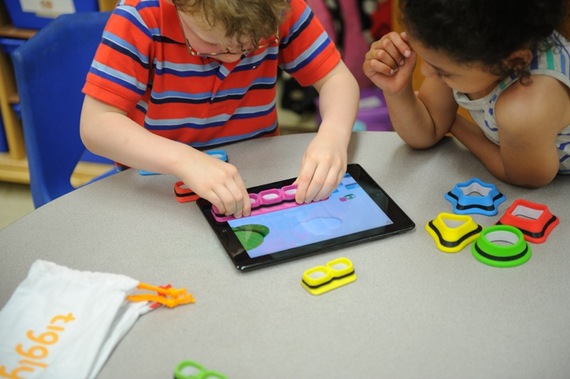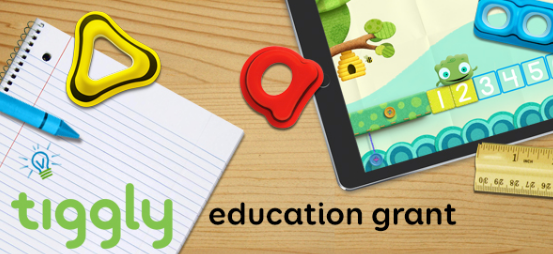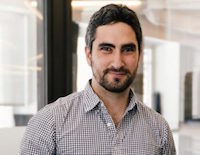What is a "stretchy thinker?" I had the opportunity to chat with Phyl Georgiou, Founder and CEO of Tiggly, who talks about this unique term and how it applies to 21st-century learners.
1. Tiggly is a company that is considered within a new line of "TABLET toys." These toys combine real-world objects with virtual play and mobile applications. Can you tell us about the background story of Tiggly? How and why was Tiggly founded?
The way young children play and learn was disrupted with the launch of the iPad in 2010. All of a sudden parents watched as children were drawn to their digital devices and away from old-school toys. We started Tiggly in 2013 as a reaction to the growing screen-time concern. We knew we had to bring physical back as 70 years of academic research from the likes of Montessori have emphasized the importance of physical play. What if we could combine classic toys, like a shape sorter, with today's digital devices? With Tiggly Shapes, Tiggly Math, and Tiggly Words we have done just that taking the best of physical and digital to create an entirely new play experience. Academic research has since shown our products are better learning tools than apps alone.
2. You currently have different apps that focus on shapes, words and math while targeting a defined learning objective in a fun and engaging manner. Can you give us an overview of how the games work, popular subjects and the age range of your audience?
With Tiggly Shapes, we focus on geometry and developing motor skills and spatial thinking for kids aged 2-4. There are many apps that teach shapes, but none of them incorporate tactile play with shape blocks, which is fundamental to every child's development. Seeing a triangle on the screen is not the same as physically holding a triangle and feeling its three sides. Tiggly Shapes is compatible with five apps that cover a range of topics from learning about animals, learning the properties of shapes, creating stories and designing characters.
With Tiggly Math, we focus on numeracy and developing number sense for kids aged 3-6. In designing Tiggly Math, we were inspired by Cuisenaire counting rods which you would find in many pre-school classrooms. Tiggly Math is compatible with three apps that cover a range of topics from counting to addition to understanding the number line. Our Tiggly Chef app is a particular favorite; stay tuned for news on a new Chef app coming soon.
With Tiggly Words, we focus on literacy and word development for kids aged 4-7. We focused on the five vowels because understanding the sounds and role of vowels in word construction is the hardest part of the English language. Tiggly Words is compatible with four apps that cover a range of topics from creating stories to developing consonant-vowel-consonant words. We recently launched an app featuring Cookie Monster and Elmo-Sesame Street Alphabet Kitchen, a very popular app that works with Tiggly Words toys.
3. There are various educational apps available today. What are some ways parents can distinguish a good application from others and how can they identify those they should avoid?
The most important thing to remember is that young children learn by playing, so the best thing a parent can do is give a child many varied opportunities to play - whether it's outdoors, or with toys or with apps. When choosing screen-time options the most important question to ask - "is the child enthusiastically and actively directing the play experience?" The more the child is in control and engaged the more likely it is a valuable learning experience. Worse screen-time is passive screen staring types. Better screen-time is child directed where the child is thinking and controlling the experience. Look for apps that encourage this kind of play.
4. You have a fantastic blog with detailed 21st-century learning tips and information for both parents and teachers. Can you tell us a bit about your writers and their backgrounds in early childhood and elementary education?
Thank you! That means a lot coming from you. Our main purpose for the blog is to close the gap between research and practice: a forum to bring together researchers, teachers, and parents to discuss what matters in parenthood and early childhood teaching/learning.
Dr. Azi Jamalian, Tiggly's co-founder and Chief Learning Officer who has a Ph.D. in cognitive studies in education from Columbia University actively writes for the blog. We also have amazing guest writers who are teachers, parents, bloggers, toy and app reviewers, or academic researchers. We have a fantastic series called "Ask an Expert" in which we interview university faculties, exemplary teachers, parents, or even toy store owners to learn what's on top of their mind and what tips they have for the rest of us.
5. Around the world, and even here in the U.S., education moves at a fluctuating and most often, quite slower pace. In one important area, there is a shrinking gap between toys and textbooks. Can you tell us about the potential implications as toys begin to replace textbooks and how that relates to both the local (U.S.) and global system for learning and connection?
It's a very interesting time when it comes to formal education environments. On the one hand, there is a lot of pressure from parents and society generally to see better test results and yet, on the other hand, there is a real appreciation from educators who understand the importance of play for young children. How do you achieve both? We see more schools investing in toys instead of textbooks. Toys can be more engaging, and toy developers have created great educational tools leveraging the latest in technology. We can't ignore the context teachers operate in - children show up to class having played Angry Birds during breakfast. To compete, we need to develop learning tools that resemble toys and not textbooks.
In fact, Tiggly believes the dichotomy between play and academic skills is completely false. Learning tools for young children have to be engaging and playful, and we're not shy to call these tools, "toys."
6. Tiggly encourages kids to be "stretchy thinkers" by supporting youth to try new things without worrying about mistakes and encouraging children to find answers in more than one way. I love the term "stretchy thinkers." In more detail, can you tell us what a stretchy thinker is and how does this type of learning parallel with the needs of 21st-century students?
Stretchy thinkers are children who stretch to find more than one answer to a problem because they enjoy the problem-solving part, and are not just finding the easiest right answer.
Stretchy thinkers are children who feel very comfortable being stretched beyond their understanding - who are not intimidated by trying to comprehend a new concept that is a bit more advanced than their existing knowledge base. They don't mind getting things wrong because they know it's just part of the process of learning.
Stretchy thinkers are children who focus on their own learning needs and do not worry about their report card or their peers. They learn because they enjoy stretching their understanding, not because they want a better grade.
Being a stretchy thinker means being prepared for the 21st-century because the best jobs of the future will require strong problem-solving skills, a comfort with stretching your understanding of the world and enjoying learning.
7. I love how Tiggly focuses on the process of learning more than focusing in on the actual answer. What are some suggestions you may have for parents as their children enter school so they can stay focused on "stretchy learning?"
Every child has a lifetime of learning ahead of them so how they perform matters today much less than how excited they are to learn tomorrow. What matters more than good grades is their attitude to learning - are they motivated to learn and do they enjoy making mistakes and trying again? At a young age, learning shouldn't be a chore and children should feel they have the ability to get better at anything if they work at it.
8. As kids get older, the emphasis on learning becomes substantially focused on memorization of facts for standardized tests. As a nation, we must move away from this type of measurement and focus on problem-solving skills, digital awareness, global communication, and creativity. How do you see Tiggly playing a larger role in achieving these goals?
Tiggly advocates for playful learning - in fact, we love to call ourselves the silliest learning company despite how seriously we take academic skills, problem-solving, and creativity.
We achieve this in the following ways:
1. Always letting the child ask "what if?" and we give them the opportunity to explore the possibilities
2. Not focusing on the final right or wrong answer- instead of letting the child enjoy the process of solving the problems
3. Give opportunities to children to express themselves through recording their stories, creating characters, or even coming up with cooking recipes
4. Letting kids make mistakes and rewarding them for taking the risk to explore something new
5. Always bringing humor in; that is something Sesame Street did very well for TV, and we want to do the same for learning on tablets
9. Over 2,300 school districts in the U.S. are using iPads in the classroom across the nation as schools begin adapting to a new digital learning approach. Now that children are spending hours looking at their iPads at school they are going home to even more screen time. What are your thoughts about this growing concern?
Devices that are more portable and more accessible are here to stay. Over time, we will see more screens everywhere we go. It is unavoidable. What is important is that children are encouraged to play outside, be social and get a balanced exposure to screens. But we cannot stop children gravitating to screens. That's why at Tiggly we are all about making screen time more active, more tactile and more playful. Academic research on Tiggly products has shown this kind of screen time has great educational results.
10. Congratulations, Scholastic named Tiggly as the Teacher's Pick for 2015, with more than 1500 schools currently using the toy. Tiggly has a Buy One-Give One program for classrooms. Can you tell us more about how this procedure works and where can teachers and parents go to access this initiative?
When a parent or a teacher purchases an individual set of Tiggly at www.tiggly.com, they can gift one to a teacher of their choice. After purchasing your set, an email is sent with instructions on how you can gift one to your teacher of choice. So anyone who purchases can gift regardless of having a code. It's one gifted set per purchase, and we limit five sets per school.
11. What does Tiggly have in store for youth for the remainder of 2016?
Best I can say is just stay tuned! A particular focus this year is updating and launching new apps, so our existing toys have an even deeper play experience. That's the benefit of a toy that has a digital component - you can keep expanding the play possibilities! In addition, we currently have a grant running for two schools. Please read more about this opportunity and how educators can apply below.
Tiggly's New Grant
Tiggly announces two grants aimed at helping close the achievement gap and bringing STEM opportunities to Title 1 students.
On April 21st, 2016, the White House recognized Tiggly for its contribution in advancing early STEM learning and Tiggly made a commitment to take part in the national effort in promoting early STEM learning. In this effort to help provide STEM options for Title 1 students, Tiggly is launching their first annual education grant to ensure that more students have access to the most advanced early learning manipulatives on the market.
Two schools will be selected to receive grants of $2,000 each, which can be used to implement Tiggly products in their school. The Tiggly Education Grants will be awarded to a Title I elementary school and a public, charter, or private elementary school. Educators, District Leaders, and Administrators are encouraged to apply at www.tiggly.com/edugrant. Applications are due by 11:59 PST July 1st, 2016.
12. Finally, where can parents and teachers purchase Tiggly for the individual user and where can schools buy Tiggly in larger quantities?
Tiggly products are for sale in Apple retail stores, Marble the Brain Stores, a number of specialty toy stores, on Amazon and Tiggly.com. Education sets can be purchased through our team. For more information, please contact educators@tiggly.com
Learn More About Tiggly
About Phyl Georgiou, Founder and CEO of Tiggly
Phyl Georgiou is the Founder and CEO of Tiggly - a leader in the connected play and learning toy space since its launch in 2013. Tiggly brings physical play to tablets by designing fun learning tech toys that interact with a series of learning apps for children 2 to 8 years old! At Tiggly, he oversees overall strategy, product design, and manufacturing. Since its launch in 2013, Tiggly has sold its products in over 20 countries and raised a total of $5m in outside funding. Phyl has an MBA from Harvard Business School and was previously a consultant at McKinsey & Company in Australia.
__________________________________________________
About Robyn: For more interviews with innovators, please see EdNews Daily.
I am also an EdTech Thought Leader at LinkedIn in the education technology and management channel; you can find more interviews there as well.
Follow Robyn Shulman on Twitter: www.twitter.com/RobynDShulman



